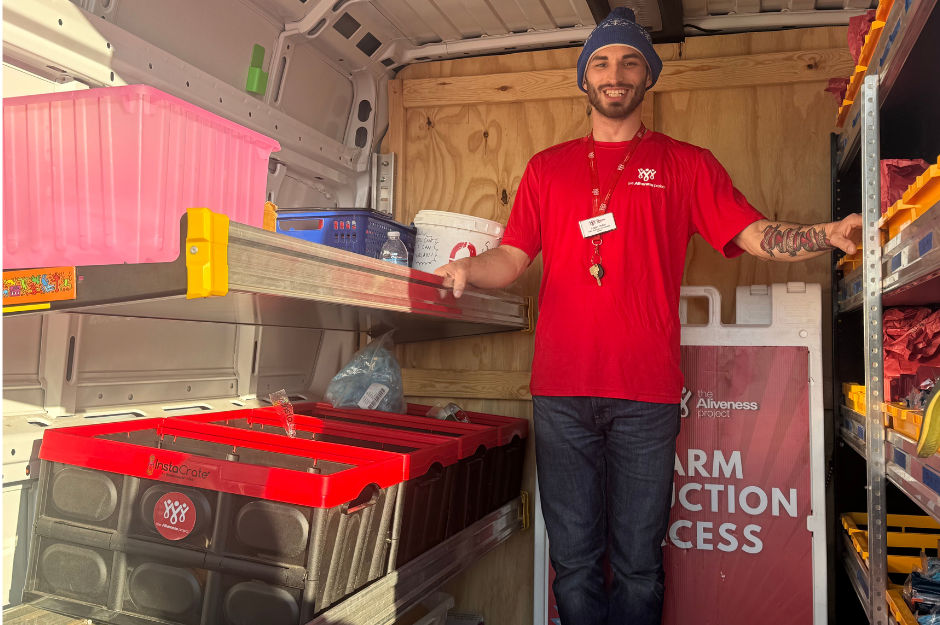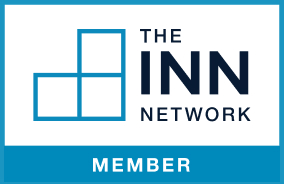Near the Franklin Street light rail station, a line of people waited by the back doors of the Aliveness Project’s red van, reciting their initials and year of birth to a staff member holding an iPad. Inside, Logan Huber, wearing a snowflake-patterned blue beanie, organized red paper bags filled with wound care kits, needles, smoking equipment, Narcan and fentanyl and xylazine test strips.
When Huber had finished filling each bag with requested items, he handed them to other members of the Aliveness Project team or to a volunteer, who passed them on to the recipients, some of whom arrived via the light rail. Staff also handed out water and snacks.
This van, named “Thrivey” by the Aliveness Project, is part of the organization’s efforts to prevent the spread of HIV. As HIV can be spread through contaminated needles, Thrivey provides people with clean needles, along with smoking equipment, a safer alternative to injection.
There are multiple outbreaks of HIV being tracked by the Minnesota Department of Health – two in Hennepin and Ramsey county, and one in the Duluth area. One of the two outbreaks in Hennepin and Ramsey is linked to injection drug users who “live or have spent time in a known encampment corridor in Minneapolis or St. Paul.” As of Sept. 3, this outbreak has been associated with 122 reported cases.
To see for myself how staff at the Aliveness Project use Thrivey to reach out to people, I rode along with a team on Friday, Nov 15.

Outside the van, a fabric wagon held different hygiene products available for people to take, from individually wrapped tampons to travel-size deodorant. The rule for these handouts, staff member Amber Muhm later told me, is that everything in there is something staff would use and buy themselves, not just the cheapest items available.
Near the wagon were two bins. One held containers meant to dispose of sharps, while the other was to collect needles themselves, gathered by those coming to the van. For every quart of needles received, the Aliveness Project gives out a $5 Cub Foods gift card.
Ideally, these needles would be held in a sharps container – like the ones in the bin next to the needle collection bin – before they are exchanged. On Friday, though, most people who showed up with needles had them in a variety of shopping bags. By the end of the shift, the collection bin was nearly full – stacked with bags and other containers of needles.
While I was only with the team for one shift, they have a weekly schedule. On Monday, Thrivey makes a midday stop at the Dorothy Day Opportunity Center in St. Paul. On Wednesday, it’s an early afternoon stop at 2500 E. Lake Street, near Target, and on Friday afternoon Thrivey visits this spot near the Franklin Street light rail station. On Tuesday afternoon, the van takes time, Muhm said, “to float and go wherever the encampments are, wherever the people are.”
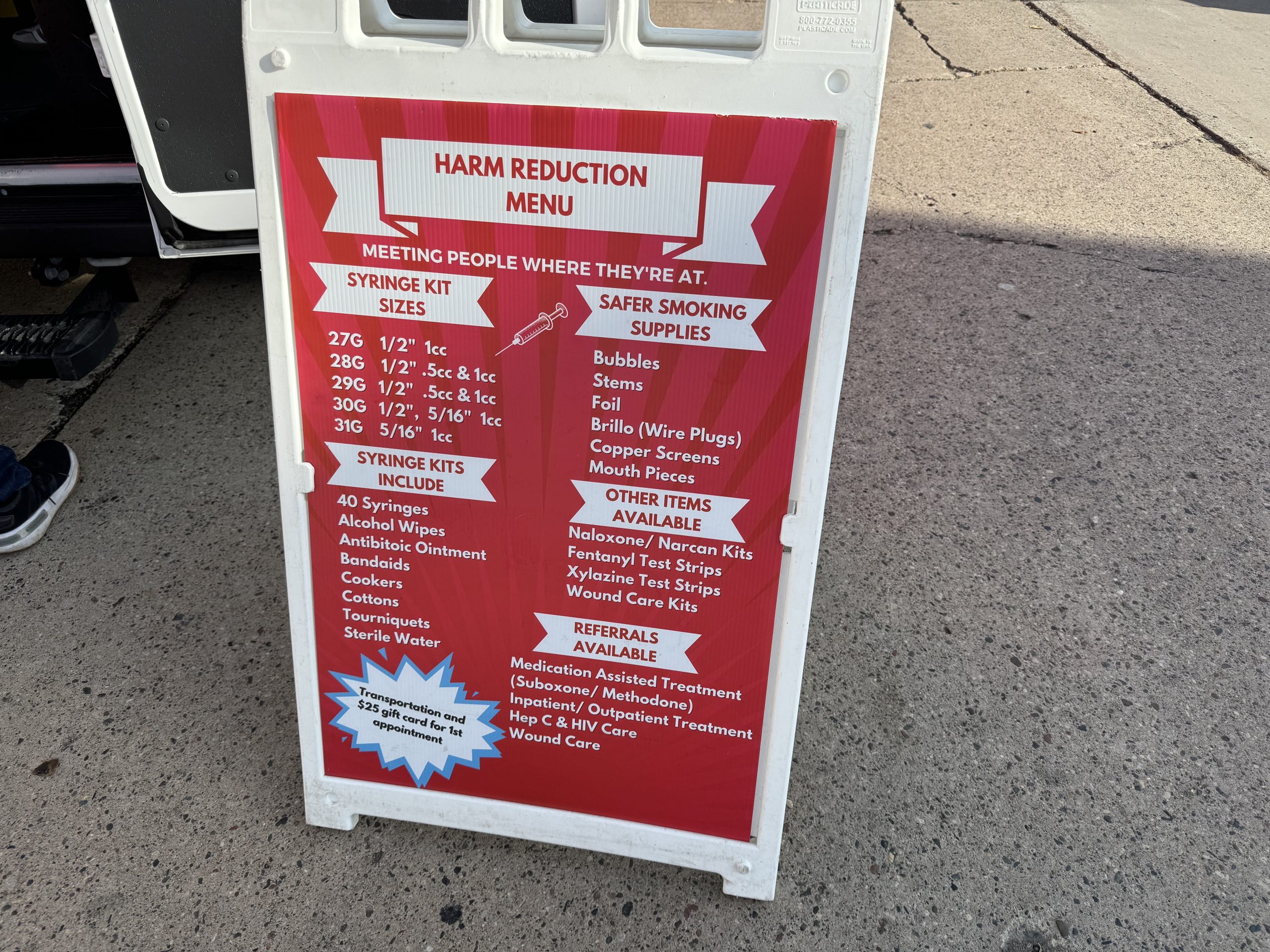
During this Friday stop, staff placed a full menu of Thrivey’s offerings near the van’s open back doors: gauge sizes of available needles and various pipe options for smoking. The menu also included this incentive: If you decide to go to medication-assisted treatment, the Aliveness Project will provide transportation to your first appointment, along with a $25 gift card.
In addition to what I saw distributed on Friday, the van also has a compartment for quick HIV testing, using INSTI testing kits. While testing wasn’t available when I was out with the team, Muhm told me that HIV testing would be available later that night at The Black Hart, a queer soccer bar in St. Paul.
Harm reduction and critics
Some critics, including members of the Legislature, said Muhm, see the van as enabling drug use, which she says is an inaccurate depiction of the team’s work.
“People say ‘They’re giving away drug paraphernalia out in public,’ and our response is kind of like, ‘Yep. And we’re also getting people into treatment. We’re also giving people Narcan. We’re also giving people wound care kits and food and a consistent schedule.’” said Muhm, a trans community specialist in the Aliveness Project’s HIV outreach and prevention program. She added that she has heard elected officials, including city council members, say that harm reduction doesn’t work, a sentiment she disagrees with and calls “frustrating.”
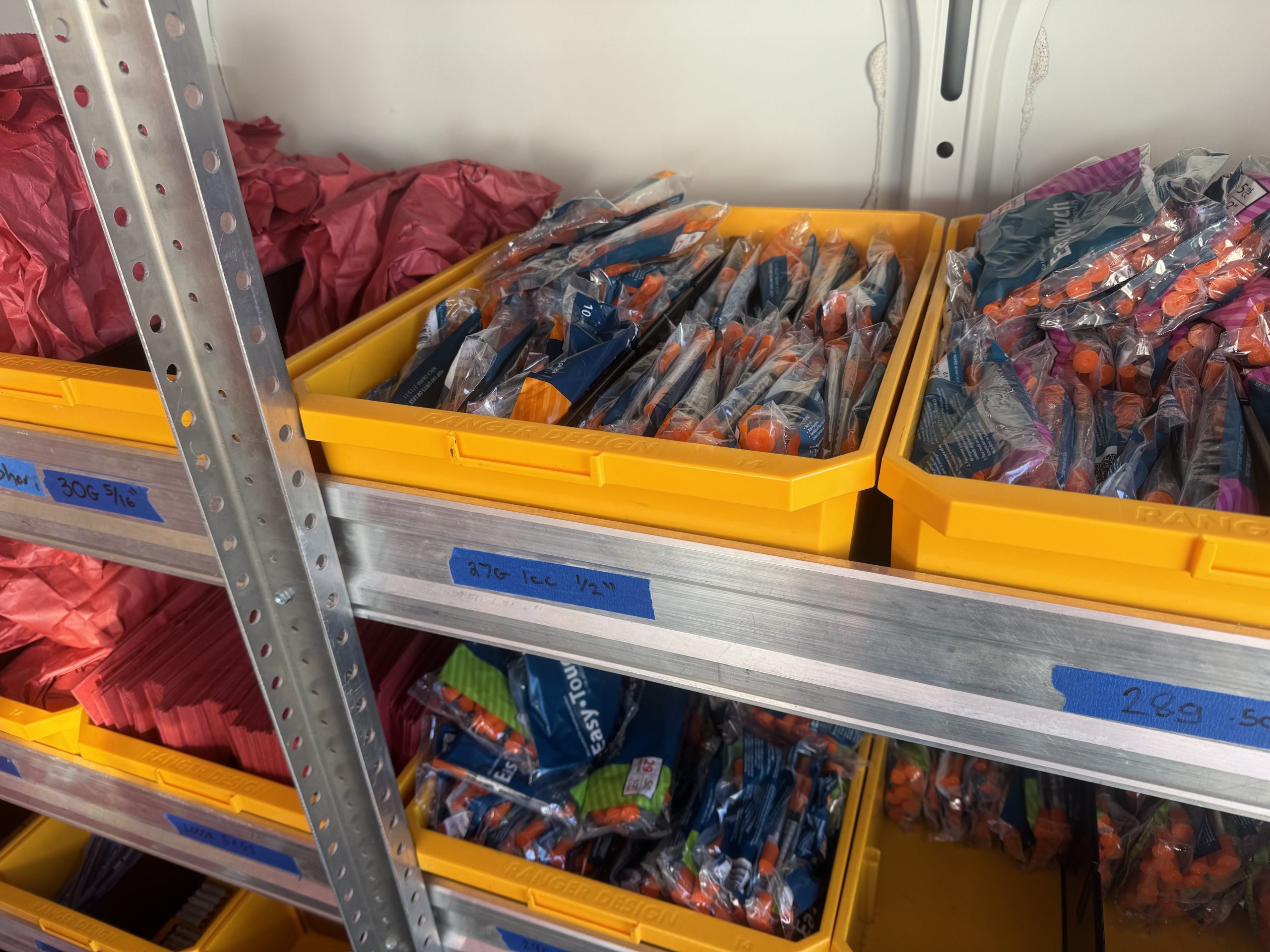
“I’ve personally seen several instances of someone coming to the van consistently over the course of eight (or) nine weeks and then finally saying, ‘Hey, I would like to go to treatment. Can you help set that up?’ This work saves lives.”
While Muhm believes in the work she and her colleagues do, she also noted that sweeps of encampments have made it difficult for service providers to find and offer harm reduction to people who are unhoused and using drugs.
“(The sweeps are) incredibly frustrating to watch both as a resident of Minneapolis and as a service provider,” Muhm said. “They happen very suddenly and even when we’re tipped off ahead of time or we respond to it, a lot of times we get there and we are not allowed to help at all. We(‘ve) witnessed firsthand how devastating it is for people.”
This destabilization has impacts on both the mental and physical health of people Muhm has seen coming to the van. When encampments are cleared, people’s belongings are dumped and they “are told to go somewhere else and then there is no somewhere else,” she said.
“They’re just in hyper-vigilance survival mode all the time. That sucks away all your energy. It leaves people in fear like, ‘When is it gonna happen next?’” said Muhm.
In terms of physical health, she added, “A lot of these camps are set up to provide community care. They’re set up in a way where people can take care of each other and where outside service providers like us can go provide supplies and get people on track to get housing, (treatment or services). If people are getting kicked out all the time and moved around, it’s really hard to build any kind of consistency and it just grinds people down over time.”
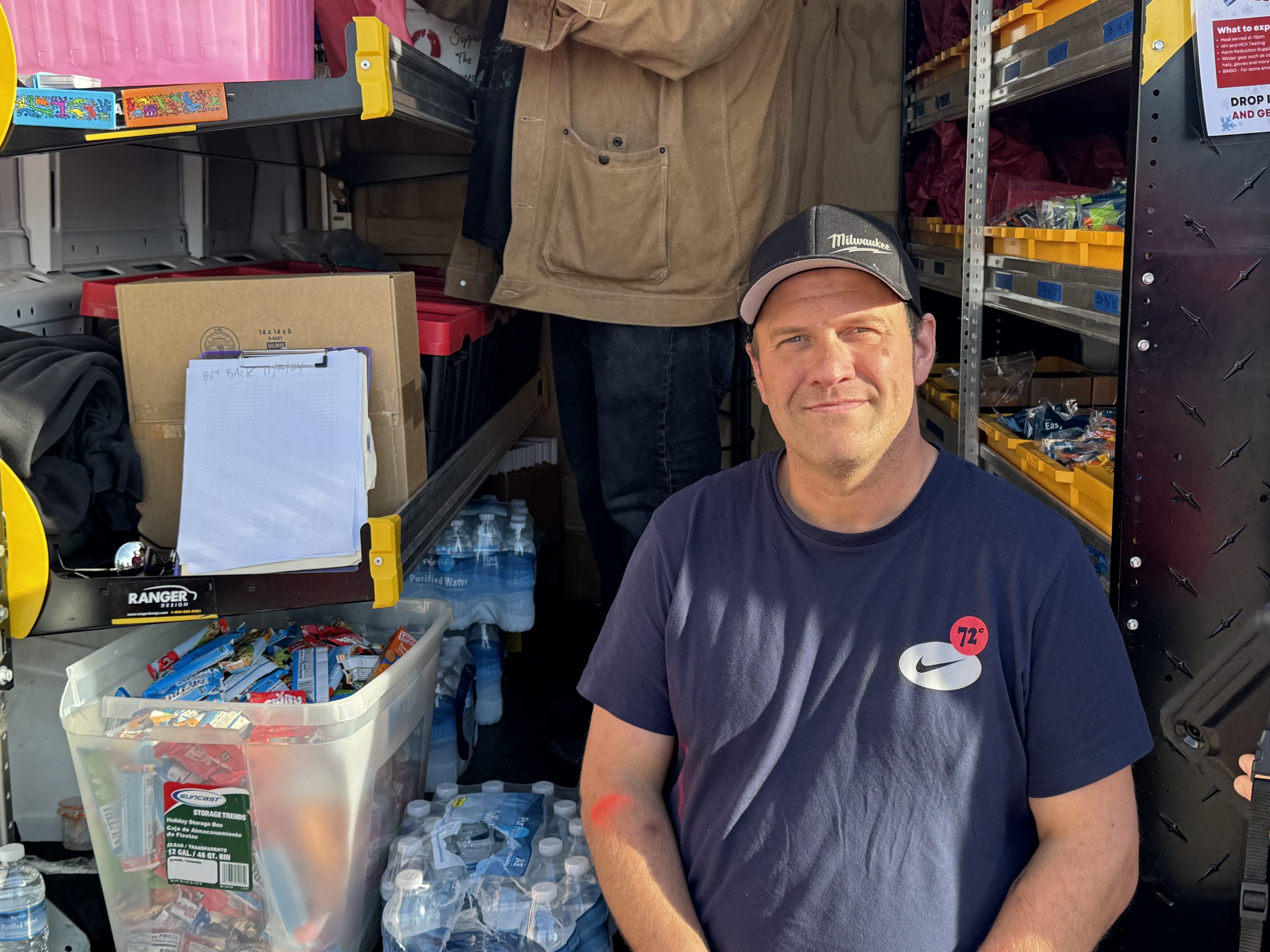
Lived experience
Huber, who was working inside the van on Friday, and Brandon Carmany, a Aliveness Project volunteer who helped hand out supplies that day, both have lived experience with the community they are assisting.
“Honestly, it feels good to give back,” said Carmany, who began volunteering two months ago with the van on Wednesdays and Fridays. “It’s nice to see people I used to interact with that are still alive. The high I get from helping others, no other drug could compare to.”
Huber, who works under the Native American Care Linkage grant at Aliveness Project, noted that many of those who come to the van for assistance are people of color or from other marginalized communities.
“As a person of color, myself, I just wanna be out here and kinda hold that space for people,” said Huber, who is from the Lower Sioux Indian community. Even while he was still using drugs himself, Huber said, he was advocating for his community, noting that due to systematic racism, harm reduction and even information about harm reduction can be inaccessible to Native Americans.
“As a result, a lot of my friends that are my age (have had) open heart surgeries (or) are dead from overdoses,” he said.
As Thrivey and its staff’s work continued, some of those approaching the van greeted or even hugged staff members, recognizing them from previous visits. One person asked about Aliveness-provided transportation to treatment. In response, Huber gave them a number to contact him with to set up transportation, whenever they were ready, wherever they were.
Where to find Thrivey
- On Mondays, Thrivey is at Dorothy Day Opportunity Center from 11:30 AM to 1:30 PM
- On Tuesdays, Thrivey travels around to find encampments from 12:30 to 2:30 PM
- On Wednesdays, Thrivey is at 2500 E Lake Street, near a Target from 1:00 to 3:00 PM
- On Fridays, Thrivey is by the Franklin Street Light Rail Station from 1:00 to 3:00 PM

